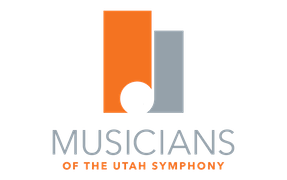Paris
The 11-hour flight from Salt Lake City to Paris is filled with light meals and intermittent sleep. But it is enough time to read, watch bits and pieces of several movies and TV shows and contemplate the next three months. Did we bring the right clothes? Will we be able to meet the people we plan to meet? Will our accommodations be okay? Will our language skills get us from one place to another? Will the money last? Five days in Paris will begin to answer these questions and more. Getting your luggage in Paris takes a while. It involves a train, passing customs and a lot of walking. Regardless, it’s a relief to see it swinging around the carousel.
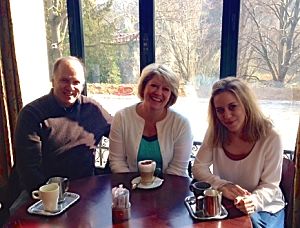
Coffee in the park with Maja Bogdanovic
We took a cab to the apartment of Maja Bogdanovic, not far from the Telegraphe Metro station in the northeast section of Paris. We were met by “Elena”, an old friend of Maja’s. Maja is a concert cellist and was off performing a new work by Penderecki with Penderecki conducting. She has an active career and most recently had performed in Lubbock, Texas, where David Cho serves as the orchestra’s Music Director. David was our assistant conductor in Utah about four years ago. The apartment is on a quiet, cobblestone street and was a welcome home for our time in the city.
We already had tickets for a concert on Day 1. Unfortunately, getting the tickets was involved and confusing. It meant securing the tickets in a spot far from the concert venue. Finding it was challenging. By the time we had made all the train connections, we had missed the Beethoven overture. Sorry, Ludwig! The orchestra was the Orchestre National de France conducted by David Afkham. Our balcony seats gave us a good view of the action and with the Brahms Violin Concerto and Bartok’s Concerto for Orchestra, there was plenty of action! Much of the audience encircles the stage below and the stairways are steep. This “Maison de la Radio” is old, but we already felt we were in Europe. Maybe it was everybody speaking French!

Bob’s birthday boat ride on the Seine
The Brahms Violin Concerto featured Viktoria Mullova on violin and a great orchestra accompaniment. The orchestra was sufficiently understated and the famous oboe solo beautifully played. The soloist was clean and commanding. We might have preferred a more romantic interpretation, but still enjoyed it. The Bartok gave the orchestra a chance to shine and the players delivered. The series of woodwind duets in the second movement and the violins made strong impressions. Getting home went a little better and a day that had started in Salt Lake City almost 40 hours earlier came to a happy, though exhausting close. By the end, Lisa was able to say, “Happy birthday!”
On our first full day, we took a boat ride down the Seine River on a huge double-decker boat. Important landmarks were pointed out in several languages. Cameras were snapping photographs at every moment. The crowds were big enough that I wondered if it was possible to photograph anything without having somebody else in your shot photographing something!
We stopped, as many Parisians do, for a cafe visit. In honor of another birthday, I had some chocolate cake and hot chocolate. The temperatures are still cold and most of the people go indoors. Within a week, the outdoor seating would take preference. We went to a really good instrument museum by the new Philharmonie de Paris and tried to get tickets for a Rossini opera being performed at the Conservatoire. It was sold out. It wouldn’t be the first time I’d say, “C’est la vie!” We dined at a sushi restaurant and enjoyed walking through the streets of Paris.

Hall of Mirrors at Versailles
The next day was devoted to seeing Versailles. Home to several Kings (Louis) and Marie Antoinette. The Mozart family spent about 12 days there when Wolfgang was seven. He made a sufficient impression for anyone who was once a child prodigy and history’s most celebrated musical genius. Of course the palace and grounds are magnificent, even weeks away from Spring. A poster of a ballet performance at the Versailles Opera House caught my attention. We got tickets, not knowing what to expect. After dinner in Versailles, we returned to the palace grounds to see “Cinderella”, music by Prokofiev. The dance company was Malandain Ballet Biarritz. The music was taped and the program gave no credit for the orchestra or conductor. Whatever group it was sounded amazing! I hoped it wasn’t a European thing (not crediting the musicians).

Malandain Ballet Biarritz
The stage was framed by 48 rows of black high-heeled shoes that hung from the ceiling. The step-mother and two ugly step-sisters were danced by men. The mother had crutches and wasn’t afraid to use them! The choreography was clever and thrilling. Headless mannequins on wheels, floor-lengthen wigs, the athleticism, beauty and synchronization was unforgettable! All this in a hall hundreds of years old. Our seats were more like benches and like the inside of Louis XIV’s bedroom, every inch was elaborately decorated! The bows commenced before the end of Prokofiev’s score and added to the energetic conclusion. If two days in France were any indication, our three months could be life-changing.
On the next day, we made a significant trek to La Chambelland on rue de Ternaux. This gluten free bakery had breads and pastries of all kinds. We ate several things there and left with several other items. It was all good. Our afternoon was spent at Père Lachaise, the most commonly visited cemetery in the world! We paid homage to composers Enesco, Bizet, Gaubert, Rossini and Chopin. Flowers covered the gravesite of Chopin, beloved all over the world!
We went to hear the Brussels Philharmonie at the new and unfinished Philharmonie de Paris. The hall is not very attractive and tractor shovels and cranes are scattered about the exterior. The dining/drinking area is without tables. Much of it seems unpainted and aisle ways lead to short walls. There were numerous bottlenecks slowing access in and out of the hall. The concert was conducted by Michel Tabachnik and featured three ballets. They pushed the orchestra back to make room for a dozen dancers. I could have done without the dancers. The choreography had little to do with the music. The music of Webern and Xenakis took up the first half. The Webern was interesting. The second half featured Stravinsky’s “Rite of Spring”, which premiered in Paris in 1913. There weren’t any riots or fistfights this time! The orchestra sounded distant. The choreographer couldn’t decide whether his dancers should or shouldn’t wear clothes and whether pulse and rhythm should go hand in hand with the score. After the experience at Versailles, this was very disappointing. We dined at La Coupole. The best part was the decor. An Art Nouveau style was everywhere. Also common in Paris are people who bring their dogs to restaurants. I’m not sure what’s on the menu for them, but they come any way! On the streets of Paris, cleaning up after your dog seems not to be encouraged.

Debussy’s grave
On March 16th we took the Metro to the Passy Cemetery. Debussy, Ibert, Faure and Manet are all buried here. The grave sites are very close together and finding one often means squeezing between headstones. Finding Debussy’s grave was important, as he is one of Lisa’s favorite composers. This cemetery is also close to where Debussy lived. We found that too, however, an Arabian princess now occupies that home and security seems to be tight.
We ate a nice lunch close to the Arc de Triomphe and then walked to one of the amazing streets in Paris, Rue de Rome. This street has dozens of music-related stores and we would leave with about a dozen new items from “La Flute de Pan”.
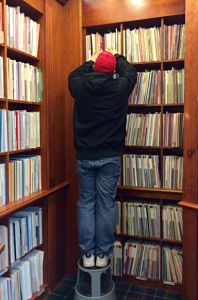
La Flute de Pan music store
Across from this store is the Lorée Oboe Shop. For 50 years I’ve been playing on Lorée oboes, so meeting the de Gourdon family and trying a dozen instruments was especially fun. I saw the photos of my (oboe) grandfather and great-grandfather, Tabuteau and Gillet, respectively. Just down the street was the old Paris Conservatoire where they went to school. We went in and walked about some. The school services the nearby musical community and has a better “feel” than the newer conservatory by the Philharmonie. Still, they both pay little homage to the musicians of the past. We enjoyed dining at a Thai restaurant with Maja. She told us it was one of Vladimir Kulenovic’s favorites.
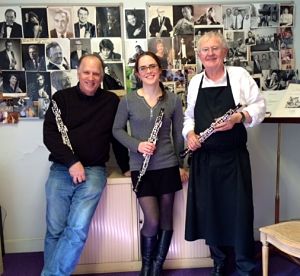
Bob at the Lorée Oboe factory with Marie-Lea and Alain de Gourdon
The next day we took the train to Mont Saint Michel. The countryside was really beautiful. Large estates, chateaus, rivers, stone walls, hamlets and green fields could be seen out our train window. The cool weather and the off season kept the crowds away from Mont Saint Michel, one of the world’s great wonders. We could see the monstrous cathedral miles from the town. It’s history goes back more than 1000 years! We had time to visit the island before dark and ate a delicious meal below the abbey. Of course the view and sunset was spectacular!
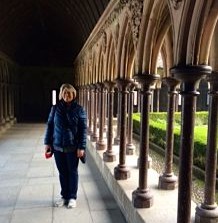
The Abbey
Our hotel was a long walk away, but we’re getting use to it! Our hotel was outside the city and very comfortable. The next morning we walked again to the shuttle, which drove us to the island. High tide was on it’s way and a new waterway has a substantial crew of workers shoveling and hauling away huge truck loads of sand. This time we made it to the abbey and enjoyed a great free roam around the massive structure. Huge stone blocks have been in place for hundreds and hundreds of years. It’s something not going anywhere soon. Gardeners and renovators service the walls, structures and gardens. The fog gave it all a feeling of mystery and amazement.
One of the surprising observances at Mont Saint Michel were the many shuttle buses. These modern day transport systems never had to turn around! The driver could drive from one end, switch a lever, walk to the other end, put his hands on a second steering wheel and drive off in the opposite direction!
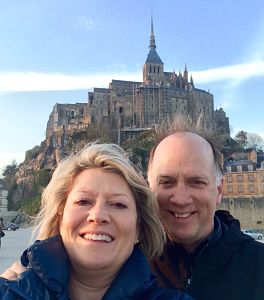
Mont St. Michel
We returned to Paris, said goodbye to our wonderful host, Maja, and left on a train for Amsterdam. Before the end of the day we were in a tall seven story house along a canal in Amsterdam. For a place built in 1663, it was a real treasure!
– Robert Stephenson and Lisa Byrnes
